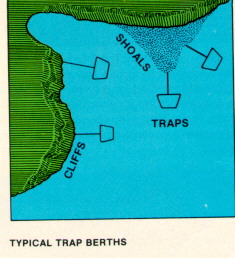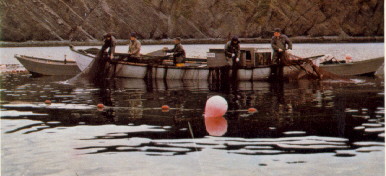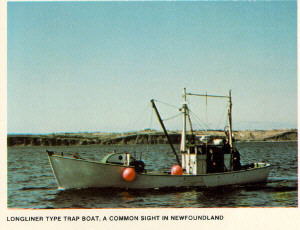
Following its development in the late 1860's the cod trap remained unchanged for over a century. During the past two decades some important modifications have been made, and the cod trap remains one of the most labour and cost effective methods of harvesting cod.
The cod trap is probably the most labour and cost efficient method ever designed for cod fishing. It was developed in the late 1860's by Captain William H. Whitely, a Newfoundland fishing skipper operating off the coast of Labrador. The stationary, untended trap was devised as an alternative to the traditional cod seine, which had to be continuously fished by a crew of men.
Captain Whitely's new gear proved so successful that within a few decades it had become virtually indispensable to fishermen along the Labrador coast. It replaced the seine entirely and became one of the most important pieces of gear used by Newfoundland fishermen.
In 1911, just over 40 years after its invention, Canadian government inspectors recorded the use of 6,530 cod traps in Labrador. By that time too, the trap was being widely used around the coast of Newfoundland. The cod trap was so effective that Captain Whitely's original design continued in use virtually without change for a full century.
The cod trap is basically a room, with four walls and a floor, constructed of netting. Fish enter the trap through a doorway in the front wall. Extending outward from the centre of the doorway is a long wall of netting which, because of its function of leading fish into the trap, came to be called the leader. The trap is kept upright in the water by floats placed along the top of the walls, and lead weights at the bottom. It is held on location by a system of corner ropes anchored to the sea bottom.
The leader, likewise buoyed and weighted, is tied to the trap at one end and made fast to the shore, or to shoal water rocks near the shore, by ropes and anchors at the other end.
When set, the bottom of the leader and the trap itself rest on the sea bottom; the top of the trap might be at the surface of the water or as much as four or five fathoms below the surface. All traditional cod traps were alike except in size. Size differences were developed by fishermen in response to local water depth, sea bottom, tide and wind conditions. The greatest differences are in the length of leaders, which generally range from 30 to 100 fathoms long. Leader length is determined by sea bottom slope. The gentler the slope, the longer the leader required to get the trap far enough off shore to sink it.
Most traps measure from 40 to 80 fathoms in circumference and 8 to 15 fathoms in depth. In a typical trap the front wall is a fathom or more longer than the back wall.
The mesh size of the netting varies from about eight inches in the leader and front wall, down to a minimum of 3 inches at the back. The reason for the different mesh sizes lies in the method of hauling the trap. Hauling starts at the front and progresses toward the back, where the fish are brought up to the surface, or "dried" up, and from there taken into the boat. The smaller mesh at the back keeps the tightly enclosed fish from escaping through the net.

Cod traps are set in places where the cod are known to migrate to shore in large numbers year after year, and where water depth and bottom conditions are suitable. The bottom should be reasonably smooth and flat and the water from 10 to 20 fathoms in depth. Most trap berths are located along the shoreline off cliffs or points of land but some are found around shoals off shore.
The cod trap season is a short one, usually starting with a slow period of quite small catches in May or early June, peaking rapidly in June or July, and tapering off just as rapidly to another low catch period in August. The trap season occurs during the annual inshore cod migration. This migration is tied to a similar inshore migration of countless millions of smelt-like pelagic fish called capelin, which usually begins in early June. The capelin, a primary food fish for cod, come ashore to spawn; the cod follow for the feast. Cod usually stay inshore a few weeks longer than the capelin, held there partly by another annual shoreward migration, this time of squid.
The fishing operation of the cod trap is simple. Fish swimming along the shore or nearby rock shoals come up against the leader. Thus diverted, they turn seaward and follow the leader into a trap.
A typical trap crew consists of four to six men. The traditional vessel that evolved for use in the trap fishery, the trap boat, is an open boat powered at first by sail and oars, later by a small gas or diesel engine. It is usually supplemented by one or two smaller row boats of similar design, or by dories. In recent years another vessel has been developed for the trap fishery. This is the trap boat longliner, a 35 to 60 foot boat, decked and diesel powered.

The cod trap is usually hauled during an ebb tide in the early morning or mid-afternoon, when the seaward flow of water helps keep the fish from leaving through the doorway. During the peak of the season a trap will be hauled two or three times a day if the catches are good.
The hauling of the trap starts at the front wall. The bottom of the doorway is pulled to the surface. As the doorway is being closed off, two ropes attached to the front bottom corners are pulled aboard, bringing up portions of the side walls and bottom.
Hauling then progresses from front to back with the sections first hauled being dropped back into the water as the haul approaches the back of the trap. The haul is complete when the fish have been dried up in a corner at the back of the trap. The netting is then fastened to the trap boat and one or two smaller boats in position at the back of the trap. The fish are then brailed into the trap boat with long-handled dipnets. Once the trap has been emptied, the walls and bottom are again let down into the water and the gear is ready to fish once more.
Probably the greatest attraction of the cod trap is the enormous amount of fish that can be taken in such a short time during the main inshore cod run. Also important is the fact that the cod trap, once set, can be left to fish on its own while the fishermen pursue other tasks, such as processing fish already caught. This was particularly important up to about 20 to 25 years ago, when practically all Newfoundland fish was salt-cured by the men who caught it.
During most of the first century of its use, trapping was the single most important method of catching cod fish in Newfoundland and Labrador. The 6,500 cod traps fished in 1911 was a high point; by 1965 the figure was still as high as 4,500. However, declining cod stocks, competition from offshore operations and new types of inshore gear reduced that number to fewer than 2,500 by 1972. The development of fisheries for other species also assisted in the decline of the cod trap fishery during the 1960's and the first half of the 1970's. In 1969, trap landings accounted for 55 percent of the total inshore cod catch. That figure had dropped to 34 percent by 1975.
In 1965-66, through a joint federal-provincial project, a number of Japanese fishing industry personnel were brought to Newfoundland to demonstrate cod trap modifications that had been developed in Japan. The Japanese cod trap, while following the same basic design and operating principles as the Newfoundland trap, was nevertheless a very different piece of equipment.
To start with, the Japanese had added a roof, to allow the trap to be set in much deeper water. The roof prevented the escape of fish over the walls. The doorway of the Japanese trap, instead of being a simple opening in the front wall, was a funnel-shaped affair that intruded into the trap and was far less likely to be used as an escape route by trapped fish.
The Japanese also added another entire room with outward-angled walls and a half-funnel type of door, to the front of the main trap. Experiments proved that the Japanese trap could be used over a wider range of locations, could catch more fish and retain them more successfully, than the traditional Newfoundland trap.
However, this gear was expensive to purchase and somewhat difficult to construct. After a few years of further experimentation, the local industry evolved an effective compromise between the expensive, complex Japanese trap and the simpler, less expensive, traditional Newfoundland trap.
This involved simply adding to the traditional trap the half-funnel doorway from the front room of the Japanese trap. This was done by adding to the old doorway a set of net panels, called winkers, which intruded into the trap on a decreasing angle, looking much like a partly-opened double house door. All three traps are now in use in Newfoundland and Labrador, the Japanese Trap in the smallest numbers and the Modified Newfoundland Trap gaining in popularity.
One further improvement in the cod trap is the use in its construction of synthetic fibres that are lighter and far more durable than the cotton twine traditionally used to make traps.
The cod trap uses no bait; it has a very positive rating in terms of fuel conservation; it is still relatively inexpensive to acquire; and it is still a superbly effective catching method wherever codfish gather in large numbers in shoal water. The problem of handling the great volume of fish landed during the trap season could be solved by better transportation and more efficient plant operation and location. Since the severe 1974 low, the cod fishery in Newfoundland began to rise on a major upward trend. Trap landings averaged more than 85 million pounds a year from 1976 to 1980. If we can maintain adequate stocks, there is no apparent reason why there should not still be a stable and viable trap fishery, especially when trap crews can combine it with other fishing methods such as handlining, gill-netting and longlining. But as time and fish have been lost, it is obvious that something needs to be done to preserve the fishery.

High-resolution sonars, a refinement of the same sounders fishermen use, also help scientists understand fish behaviour. They allow scientists to find and actually "see" the fish far beneath their research ships. A computer then processes the sonar data to generate a vivid snapshot of a school of fish and how the school is organized.
Every year scientists comb the ocean surveying the abundance of groundfish, including the all-important northern cod. Technicians sort, measure, weigh each fish and determine the sex. The data is carefully recorded and compared to surveys done in other years.
Sometimes some of the livelier fish are set aside for tagging - an old, reliable method of tracking where fish move. The tag is attached to a wire passed through the muscle under dorsal fin. Numbers on the tag record where and when the fish was first caught. When people who catch tagged fish return the tags together with details of the time and place, the tags can supply a lot of valuable information on fish growth and movement.